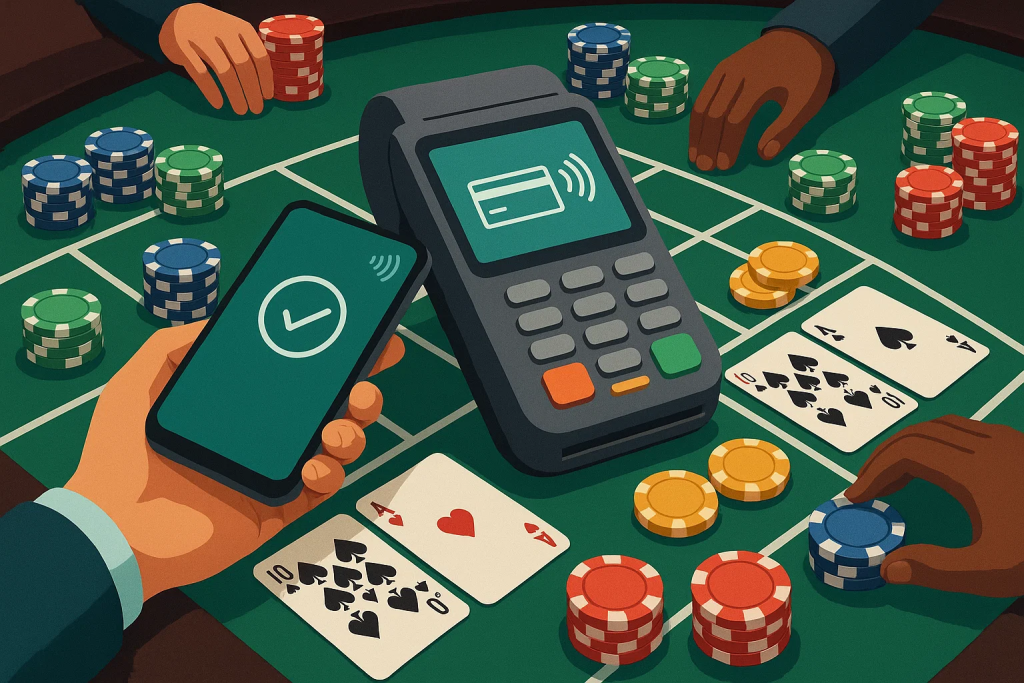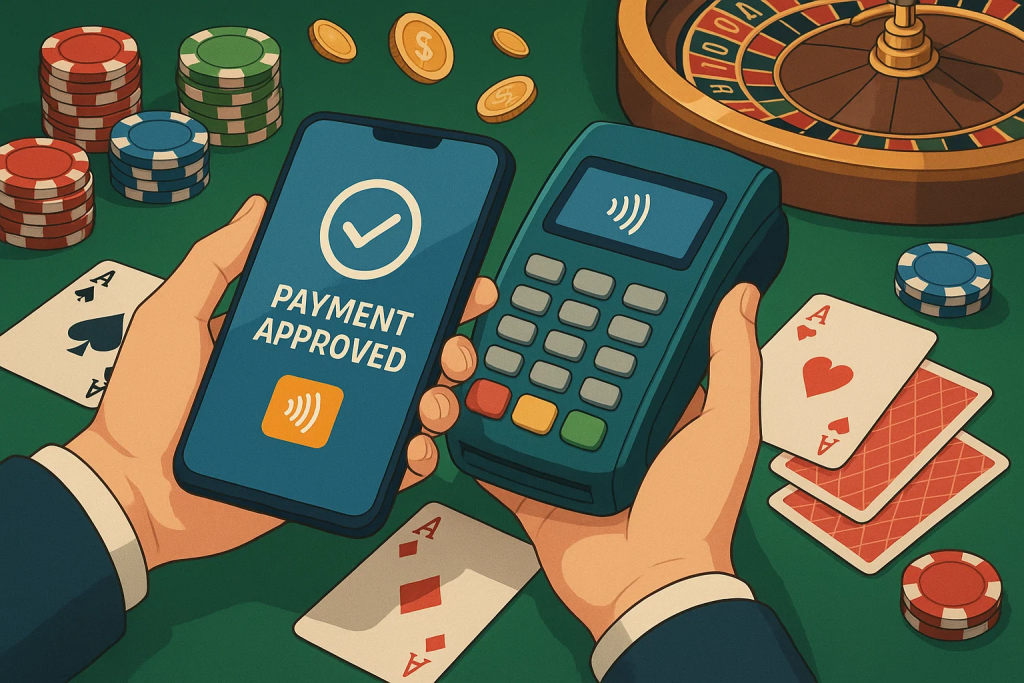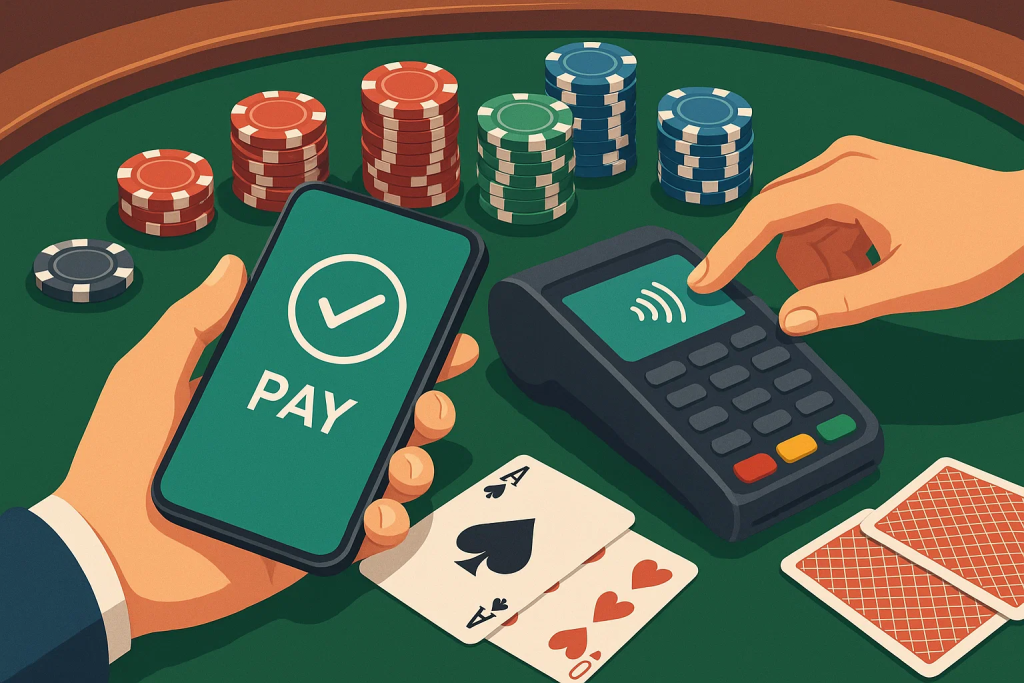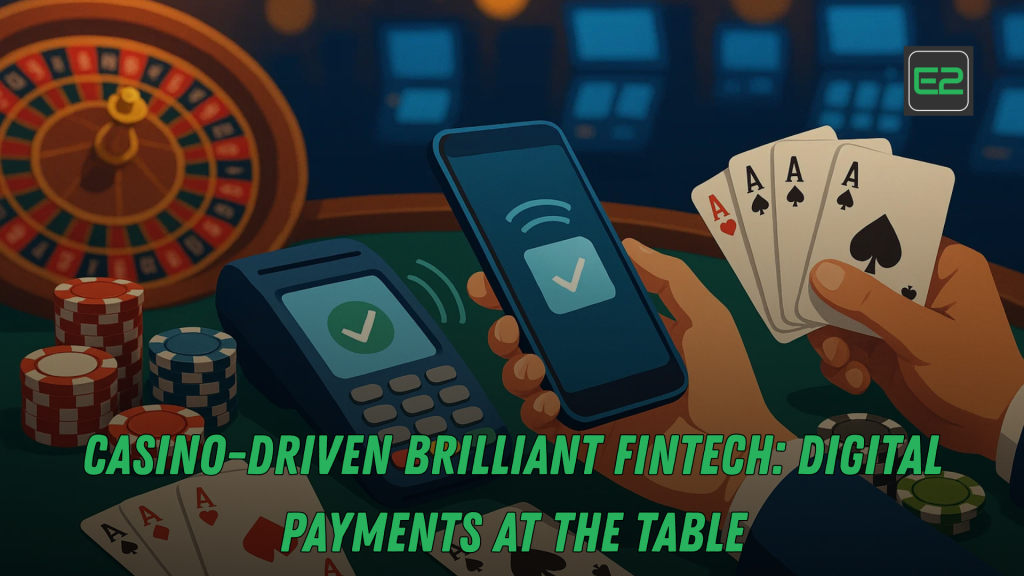Table of Contents
Executive Overview
Casinos are no longer just houses of games; they’re payments companies in disguise. As cash handling gets riskier, regulations tighten, and younger guests expect tap-and-go convenience, digital payments at the table have shifted from pilot to priority. “Casino-driven fintech” describes the technology stack, governance, and product design that let players buy in, top up, and cash out using e-wallets, tokenized cards, instant bank rails, or even RFID/NFC-enabled chips—without leaving the felt.
This playbook explains:
- What “digital payments at the table” means (and what it isn’t)
- The business case and KPIs operators should use to measure ROI
- A reference architecture (apps, readers, ledgers, risk engines, AML/KYC)
- The dealer and pit workflow that keeps the game fast and compliant
- Responsible gaming features embedded at point-of-play
- Cybersecurity & privacy controls (tokenization, device attestation, data minimization)
- A pragmatic 30–60–90 day rollout plan and a one-year roadmap
- Future trends (real-time payments, biometrics, CBDCs, programmable loyalty)
- A strong CTA and 5 FAQs to help you take the next step

1) What “Casino Digital Payments at the Table” Really Means
Definition: The ability for a patron to transact directly from the table—for buy-ins, re-buys/top-ups, and cash-outs—using cashless instruments integrated with the casino’s cage, cage-less wallet, or player account system. The experience should be as quick as cash, safer than cash, and more measurable than cash.
Core modalities:
- Casino e-wallet / player wallet (funded via card, bank transfer, or cash at kiosk/cage)
- Tokenized card-on-file (PAN never touches the table device; uses network tokenization)
- QR payments (wallets present QR, table reader or dealer tablet confirms)
- NFC / contactless (tap to authorize top-ups where permitted)
- Instant bank rails (RTP-style transfers in markets where available)
- RFID/NFC “smart chips” (table reads chip stacks; settlement occurs to wallet/ledger)
Not required: crypto speculation or unregulated assets. Some operators explore stablecoins or tokenized deposits, but only within full KYC/AML and fiat on/off ramps.
2) Why Casinos Are Becoming Fintechs
2.1 The Business Drivers
- Faster play, higher time-on-device: Cashless top-ups reduce pit friction and “walk-away” risk.
- Lower cash handling cost & shrinkage: Fewer armored pickups, counterfeit exposure, and counting errors.
- Better AML/KYC & auditability: Digital trails help satisfy regulators and reduce investigation time.
- Personalized marketing: Wallet data + consented behaviors power real-time offers and loyalty boosts.
- Younger demographics: Guests raised on e-wallets and contactless expect seamless payment everywhere.
2.2 The Compliance Drivers
- Global focus on beneficial ownership, source of funds, and transaction monitoring
- Push toward responsible gambling tooling at the point of play (limits, cool-offs, self-exclusion checks)
- Data protection expectations (privacy-by-design) across jurisdictions
3) The Table-Side Workflow of a Casino(Player & Pit)
A) Buy-in
- Player opens wallet app or presents tap/QR.
- Dealer/pit boss initiates request on table tablet/reader tied to table ID and game ID.
- Payment orchestration routes to the appropriate rail (tokenized card, wallet balance, or bank).
- Ledger posts pending authorization; dealer receives go/no-go within seconds.
- Chips issued; digital receipt added to player wallet; PIT & CMS (casino management system) updated.
B) Top-up / Re-buy
- One-tap repeat of last method or scan-to-pay QR.
- Velocity checks and affordability limits run in the background; RG prompts if thresholds near.
C) Cash-out
- Dealer tallies chips; table reader detects RFID/NFC (if deployed) and posts cash-out request.
- Funds settle back to wallet; player may keep funds digital or withdraw at kiosk/cage/bank.
- Transaction record syncs to AML & audit logs.
Key principle: Speed without shortcuts. Everything that keeps the game moving (UI, hardware ergonomics, pre-authorized top-up bands) must coexist with strong controls (KYC, sanctions, SAR triggers, device attestation).
4) Reference Architecture: From Felt to Ledger
Front-end & Edge
- Player wallet app (iOS/Android, web portal)
- Dealer/pit tablet + EMV/PCI PTS-certified reader (NFC/QR/RFID)
- Smart chip racks or table antennas (where allowed), with anti-tamper seals
Middle-tier
- Payment orchestration (rules engine chooses card/ACH/instant rails)
- Wallet & ledger services (double-entry, sub-accounts, reconciliation)
- Risk & AML engines (KYC, watchlists, transaction monitoring, case management)
- Offer/loyalty engine (real-time benefits, comps, milestones)
Core integrations
- CMS/Pit (player tracking, ratings, limits)
- KYC/Identity (document verification, liveness, age checks)
- Data lake (analytics, attribution, RG insights)
- Reporting (regulatory extracts, accountants’ packs, cage reconciliation)
Security envelope
- End-to-end encryption (mPOS↔gateway↔ledger), HSM for key management
- Tokenization of PAN and PII; role-based access; zero-trust network; device attestation
- Audit trails, immutable logs, SOAR/SIEM alerting
5) Casino Payment Modes: Pros, Cons, and Where They Fit
- E-wallet / Player wallet
- Pros: Lowest friction for repeat visits, supports RG limits, instant comps.
- Cons: On-ramp UX critical; funding sources must be transparent.
- Tokenized cards
- Pros: Familiar to players; network risk tools (3DS/SCA) available.
- Cons: Interchange fees; chargeback handling; must avoid card data at edge.
- QR
- Pros: Works on almost all devices; good for bring-your-own-wallet ecosystems.
- Cons: Camera friction under low light; table choreography needed.
- NFC/contactless
- Pros: Fastest table-side experience.
- Cons: Requires certified readers and clear pit SOPs.
- Instant bank rails
- Pros: Lower cost than cards; high acceptance caps.
- Cons: Fragmented by country; settlement nuances; refund flows must be designed.
- RFID/NFC “smart chips”
- Pros: Real-time chip accounting, anti-counterfeit, faster cash-out.
- Cons: Hardware cost, maintenance, and regulatory approvals.
6) Responsible Gaming by Design (at the Table)
- Deposit & loss limits (daily/weekly/monthly), set in app or at kiosk with KYC
- Time-on-device prompts and reality checks at defined intervals
- Self-exclusion enforcement at onboarding and before every top-up
- Affordability insights (when legally permissible) and cool-off options
- Nudges: gentle messaging when nearing limits; links to help resources 24/7
Treat RG controls like seatbelts—always present, never in the way. Make limits easy to set and hard to override without cooling-off.

7) Compliance & Risk: What Regulators Expect
- KYC/Identity: document verification, liveness checks, ongoing PEP/sanctions screening
- Transaction monitoring: typologies for structuring, rapid top-up/cash-out loops, third-party funding, mule behavior
- Source-of-funds/wealth thresholds with enhanced due diligence
- Device & location controls: geofencing, anomaly detection, device fingerprinting
- Reporting: SAR/STR filings, threshold reports, suspicious patterns escalation
- Payments compliance: PCI DSS for card flows; strong customer authentication where mandated
- Privacy: data minimization, consent management, right-to-access/delete per jurisdiction
Pro tip: Build a compliance backlog alongside product sprints. Every feature (e.g., instant cashback) maps to control narratives and test cases for audit.
8) Online Casino Cybersecurity: Locks on Every Door
- Zero-trust segmentation: pit devices can’t talk laterally without policy
- Secure boot & signed firmware on readers/tablets; tamper detection on housings
- Least-privilege IAM: just-in-time access, MFA/U2F for admins
- Threat modeling of table workflows (spoofed QR/NFC, relay attacks, rogue APs)
- Red team exercises before each major expansion; tabletop incident drills
- Backups & BCP: offline procedures if a payment rail fails mid-session
9) UX That Dealers and Players Actually Love
- Two-tap top-ups: preset chips stacks (e.g., 100/200/500) with quick confirm
- Readable UI in low light; haptic feedback on dealer tablets
- Footwork choreography: place readers where dealers can move naturally
- Sand-to-felt reality: microfiber wipes, anti-glare screens, spill-resistant housings
- Accessibility: font scaling, color-blind palettes, multi-language toggles
10) The Economics: Build a Defensible ROI
Cost buckets: hardware (readers, racks), software licenses, orchestration fees, payment processing, AML/KYC vendors, support.
Benefit levers:
-
- Time-on-device and hands per hour from faster top-ups
- − Cash handling (labor, CIT fees, reconciliation errors)
- − Shrinkage/counterfeit risk
- Offer attribution (better comp ROI)
- Regulatory efficiency (fewer man-hours per audit finding)
Core KPIs:
- Cashless adoption rate (% of buy-ins via digital)
- Top-up success time (initiation → authorization)
- Abandonment (initiated but canceled)
- RG engagement (limits set, cool-offs used)
- Chargeback & fraud rate (per instrument)
- Audit cycle time (find → close)
11) Casino Implementation: 30–60–90 Days + One-Year Roadmap
Days 1–30 — Foundation
- Form payments squad (Product, Pit Ops, AML, Cage, IT Sec, Compliance).
- Select pilot game types (e.g., blackjack + baccarat) and two pits.
- Lock vendors: wallet/orchestration, KYC/AML, reader hardware.
- Draft table SOPs and training scripts for dealers & pit bosses.
- Build MVP flows (buy-in, top-up, cash-out) with RG limits and device attestation.
Milestone: Dry-run on a closed table; end-to-end ledger posts within SLA.
Days 31–60 — Pilot Live
- Soft-launch after midnight windows; collect latency & error telemetry.
- Hold daily standups with pit leads; iterate UI, button order, suggested top-up stacks.
- Begin RG A/B tests (opt-in prompt placement).
- Rehearse offline fallback (rail down, battery fail, reader swap).
Milestone: 25–35% cashless adoption on pilot tables with <5s top-up median.
Days 61–90 — Expansion & Governance
- Add second instrument (e.g., instant bank rail alongside wallet).
- Stand up case management and SAR workflows tied to telemetry.
- Publish operational dashboards (adoption, failures, RG interactions).
- Kick off dealer certification program for cashless tables.
Milestone: 45–55% cashless adoption; audit-ready controls; NPS from dealers ≥ +40.
One-Year Roadmap
- Scale to all pits across primary properties; standardize with playbooks.
- Introduce RFID/NFC smart chips where licensed.
- Launch real-time offers (drink/meal/room) triggered by wallet events.
- Integrate open-banking and instant pay-outs for verified wallets.
- Add biometrics (face/palm) for step-up auth on high-risk actions (opt-in).
12) Content & Loyalty: Your Secret Growth Engine
- “Moments marketing”: Celebrate top-ups that cross milestones with responsible, tasteful prompts.
- Tier accelerators: Wallet-only multipliers during low-traffic hours.
- Consent-based personalization: Explain the value exchange; let players choose comms channels.
- Storytelling: Short clips of how cashless works, dealer tips, and RG features—proactive transparency builds trust.
13) What Not to Do on a Casino
- Don’t launch a rail without offline playbooks.
- Don’t bury RG settings three taps deep.
- Don’t ignore dealer ergonomics—the pit will reject what slows the game.
- Don’t store sensitive data on table devices; use tokens and short-lived credentials.
- Don’t assume regulators will infer controls—document control narratives and test cases.
14) Future Trends to Track
- Real-time payments (RTP, FedNow-style, PIX-style rails) for instant wallet funding and pay-outs
- Biometric payments (face/palm) with strong consent and privacy boundaries
- CBDCs & tokenized deposits in regulatory sandboxes for settlement efficiency
- Programmable loyalty (smart rules that issue benefits on verified behaviors)
- AI-driven AML (graph networks to reveal mule rings, collusion, chip walking analogs)
- Differential privacy for analytics that respect data minimization
Call-to-Action
Ready to turn your casino into a fintech-grade payments operation—without slowing the game?
- Reply “SEND TABLE PAYMENTS KIT” to get a free bundle: MVP user flows, dealer SOPs, RG checklist, and a control narrative template for audit.
- Want a 30-minute roadmap review of your pilot? Say “BOOK REVIEW” and include your target go-live month and game types.
- Players & guests: Ask your favorite property about wallet options and responsible gaming tools—and help shape the future by opting in to feedback.
Final Word
“Casino-driven fintech” is not a buzzword; it’s the operating model for modern gaming. When you fuse table-side digital payments with rock-solid compliance, dealer-friendly UX, and responsible gaming by design, you get a system that plays faster, audits cleaner, and markets smarter. Build it once—with care—and it will scale across pits, properties, and jurisdictions. The felt is ready. Your move.

The article frames modern casinos as fintech operators in disguise, arguing that table-side digital payments—wallets, tokenized cards, QR/NFC, instant bank rails, even RFID/NFC “smart chips”—have moved from experiment to priority. The goal is to let players buy in, top up, and cash out without leaving the felt, matching the speed of cash while improving safety, auditability, and customer experience.
Why it matters. Casino operators pursue cashless tables to (1) speed play and raise time-on-device, (2) cut cash handling costs and shrinkage, (3) strengthen AML/KYC and audit trails, (4) unlock personalized marketing from wallet data (with consent), and (5) meet the expectations of younger, mobile-first guests. Regulators simultaneously expect clear identity controls, source-of-funds checks, transaction monitoring, and privacy-by-design.
How it works. A typical flow: the dealer/pit initiates a buy-in on a certified reader/tablet; orchestration routes the payment via the chosen rail; the ledger posts authorization; chips are issued and a digital receipt lands in the player wallet; casino management systems update. Top-ups repeat with one tap or a QR scan, guarded by velocity and affordability checks. Cash-outs tally chips (optionally via RFID racks), then settle back to the player wallet for withdrawal at kiosk/cage/bank.
Reference stack. Edge devices (dealer tablets, EMV/PCI readers, optional smart chips) connect to payment orchestration, wallet/ledger services, risk & AML engines, and offer/loyalty systems, integrated with KYC/Identity, the casino management system, and a data lake. Security uses end-to-end encryption, HSMs, tokenization, device attestation, zero-trust networks, immutable logs, and SIEM/SOAR alerting.
Payment options—fit & trade-offs.
- Player e-wallets: best repeat UX, supports responsible-gaming (RG) limits; requires smooth funding.
- Tokenized cards: familiar, leverage network risk tools; watch interchange and chargebacks.
- QR & NFC: broad compatibility vs. fastest tap experience; plan for low-light/table ergonomics.
- Instant bank rails: cheaper, higher caps; fragmented by market.
- Smart chips: real-time accounting and faster cash-outs; higher hardware/regulatory overhead.
Responsible gaming by design. The system embeds deposit/loss/time limits, reality checks, self-exclusion enforcement, cool-off paths, and discreet nudges—treated like seatbelts that are always available yet unobtrusive.
Compliance & risk. Beyond KYC and sanctions screening, casinos need typology-aware transaction monitoring (e.g., rapid top-up/cash-out loops, third-party funding), device/location controls, formal SAR/STR processes, and PCI DSS alignment for card flows. Privacy requires data minimization, consent management, and honoring data rights.
Dealer-friendly UX. Two-tap top-ups, preset chip stacks, haptic confirmations, anti-glare hardware, spill-resistant housings, readable UIs, and smart reader placement preserve game speed and adoption.
Economics & KPIs. Benefits: higher hands/hour, lower cash costs, reduced counterfeit/shrink, improved comp attribution, faster audits. Track cashless adoption, top-up latency, abandonment, RG engagement, fraud/chargebacks, and audit cycle time.
Rollout plan.
- Days 1–30: Form a cross-functional payments squad, pick pilot pits/games, lock vendors, script SOPs, build MVP flows with RG and device attestation.
- Days 31–60: Soft-launch, iterate daily with pit leads, test RG prompts, drill offline fallbacks.
- Days 61–90: Add a second rail, stand up case management & dashboards, certify dealers.
- One year: Scale property-wide, evaluate RFID chips, launch real-time offers, integrate open-banking/instant payouts, pilot biometric step-up auth (opt-in).
Growth engine & guardrails. Use moments marketing, tier multipliers, consented personalization, and transparent “how cashless works” content. Avoid launching without fallbacks, burying RG settings, ignoring ergonomics, storing sensitive data on table devices, or under-documenting controls.
Future outlook. Expect real-time payments, biometric payments, CBDC/tokenized deposits, programmable loyalty, AI-driven AML, and privacy-preserving analytics to shape the next wave. Bottom line: casino-driven fintech fuses table-side payments with robust compliance and great UX to play faster, audit cleaner, and market smarter.
Frequently Asked Questions (FAQ)
1) Do we need to go fully cashless to start on Casino?
No. Most operators begin hybrid: cash and digital side by side on selected tables. Use KPIs (adoption, latency, RG usage) to guide expansion. Full cashless is a policy decision, not a technical prerequisite.
2) Will digital payments slow the game?
Done right, they speed it up. Two-tap top-ups, preset stacks, and reader placement cut friction. Pilot at low-traffic hours, refine choreography, then scale.
3) How do we protect privacy and comply with data laws?
Use tokenization, data minimization, consent management, and role-based access. Keep PAN/PII off table devices. Provide clear privacy notices and honor data subject rights where applicable.
4) What about fraud and chargebacks?
Combine network risk tools (3DS/SCA) with behavioral analytics, device fingerprinting, velocity checks, and transaction monitoring tuned for gaming typologies. Maintain case management to escalate suspicious activity and file SARs/STRs when required.
5) How long does a pilot take?
A focused team can stand up an MVP in 60–90 days across a handful of tables—assuming vendor selection, KYC/AML integrations, and dealer training start in parallel. Scale property-wide over subsequent quarters with phased hardware installs and SOP certification.
